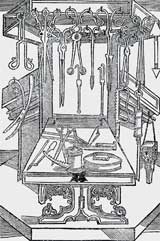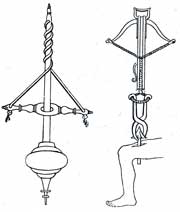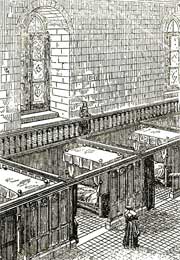Medieval Medicine History
There are two distinct periods in the history of Medieval medicine. The first concerns the early stages, from the 6th to the 9th century, and is occupied mainly with the contributions to the Medieval medicine made by those who were still in touch with the old Greek writers; while the second represents the early Renaissance, when the knowledge of the Greek writers was gradually filtering back again, sometimes through the uncertain channel of the Arabic.
The real history of Medieval scientific medicine is eclipsed by the story of the popular one. So much has been said of the medical superstitions, many of which were rather striking, that comparatively little space has been left for the serious medical science and practice of the time, which contains many extremely interesting details. When we turn our attention away from this popular pseudo-history of Medieval medicine, which has unfortunately led so many well informed persons into entirely wrong notions with regard to medical progress, we find much that is of enduring interest.
The first documents that we have in the genuine history of Medieval medicine, after the references to the organizations of Christian hospitals at Rome and Asia Minor in the 4th and 5th centuries, are to be found in the directions provided in the rules of the religious orders for the care of the ailing. St. Benedict (480 - 543), the founder of the monks of the West, was particularly insistent on the thorough performance of this duty.

Brunschwig's Surgical Armamentarium
One of the rules of St. Benedict required the Abbot to provide in the monastery an infirmary for the ailing, and to organize particular care of them as a special Christian duty. The wording of the rule in this regard is very emphatic. The care of the sick is to be placed above and before every other duty, as if, indeed, Christ were being directly served in waiting on them. It must be the peculiar care of the Abbot that they suffer from no negligence. The Infirmarian must be thoroughly reliable, known for his piety and diligence and solicitude for his charge. The last words of the rule are characteristic of Benedict's appreciation of cleanliness as a religious duty, though doubtless also the curative effect of water was in mind. "Let baths be provided for the sick as often as they need them." Cassiodorus (468& -560), who had been the prime minister of the Ostrogoth Emperors, had his rule founded on that of the Benedictines. He promoted the herbal medicine, by recommending to learn the nature of herbs, and study diligently the way to combine their various species for human health; but he advised to not place your entire hope on herbs, nor seek to restore health only by human counsels. Since medicine has been created by God, and since it is He who gives back health and restores life, turn to Him.
The monasteries are thus seen to have been in touch with Greek medicine from the earliest medieval times. The other important historical documents relating to Medieval medicine which we possess concern the work of the men born and brought up in Asia Minor, for whom the Greeks were living influences. Aëtius, Alexander of Tralles, and Paul of Egina have each written a series of important chapters on medical subjects, full of interest because the writers knew their Greek classic medicine, and were themselves making important observations.
Medieval Medicine Schools
The first medical school of modern history, and the institution which more than any other has helped us to understand the Medieval medicine, is that of Salerno, formally organized in the 10th century but founded a century earlier, and reaching a magnificent climax of development at the end of the 12th century. Anyone who might be tempted to think that Medieval medicine was not taken seriously, or that careful clinical observations and serious experiments for the cure of disease were not made at Salerno, will be amply contradicted by the reading of De Renzi.
Above all, he makes it very clear that medical education was taken up with rigorous attention to details and high standards maintained. Three years of college work were demanded in preparation for medical studies, and then four years of medicine, followed by a year of practice with a physician, and an additional year of special study in anatomy had to be taken if surgery was to be practiced. All this before the license to practice medicine was given.
Probably the best way to convey in brief form a good idea of the medicine teaching in Medieval Salerno is to quote the Regimen Sanitatis Salernitanum, the Code of Health of the School of Salernum, which for many centuries was so popular in Europe. The Regimen was written in the rhymed verses which were so familiar at this time. It was not written for physicians, but for popular information, and it seems to have been a compilation of maxims of health from various professors of the Salernitan School. From the Code, we find that the medieval hygienists believed very much in early rising, cold water, thorough cleansing, exercise in the open air, yet without sudden cooling afterwards.
The Salernitan writers were not believers in noonday sleep, though one might have expected that the tradition of the siesta in Italy had been already established. They insist that it makes one feel worse rather than better to break the day by a sleep at noonday. They believed in light suppers, and with regard to the interval between meals, the rule was, wait until your stomach is surely empty. Pure air and sunlight were favorite tonics. The tradition with regard to the difficulty of the digestion of pork, had already been established. The digestibility of pork could, however, be improved by good wine. Milk for consumptives was a favorite recommendation. The tradition had come down from very old times, and Galen insisted that fresh air and milk and eggs was the best possible treatment for consumption. The Salernitan physicians recommended various kinds of milk, goat's, camel's, and sheep's milk as well as cow's. The Regimen warned, however, that milk will not be good if it produces headache or if there is fever. They recommended the various simples, mallow, mint, sage, rue, the violet for headache and catarrh, the nettle, mustard, hyssop, elecampane, pennyroyal, cresses, celandine, saffron, leeks - a sovereign remedy for sterility - pepper, fennel, vervaine, and henbane.

Surgical Instruments of Guy de Chauliac-
On the right, a balista for extraction of arrows
One very interesting contribution to medical literature that comes to us from Salerno is "The Coming of a Physician to His Patient, or an Instruction for the Physician Himself." It illustrates very well the practical nature of the teaching of Salerno, and gives a rather vivid picture of the medical customs of the time.
The next great medical school contributing to the development of Medieval medicine was that of Montpellier in the South of France. Montpellier, situated not far from the Mediterranean, came to be a health resort. Patients flocked to it from many countries of the West of Europe; physicians settled there because patients were numerous, medical instruction was offered to students, and soon the school became famous. The fundamental reason for this striking development of the intellectual life seems to have been that Montpellier was not far from Marseilles, which had been a Greek colony originally and continued to be under Greek influence for many centuries. As a consequence of this the artistic and intellectual life of the southern part of France was higher during the earlier Middle Ages than that of any other part of Europe, except certain portions of South Italy.
A number of great men defining the history of Medieval medicine made their medical studies at Montpellier in the 12th and 13th centuries. Among them are Mondeville, who afterwards taught surgery at Paris; and Guy de Chauliac, who was a Papal Physician at Avignon and at the same time a professor at Montpellier, probably spending a certain number of weeks, or perhaps months, each year in the university town. One of the distinguished professors at Montpellier was Arnold de Villanova, of whose name there are a number of variants, including Rainaldus and Reginaldus. A very well-known teacher who has had a reputation in English speaking countries because his name was supposed to indicate that he was a Scotsman, was Bernard Gordon or de Gordon, or Gourdon. He was a teacher at Montpellier at the end of the 13th century and the beginning of the 14th century.
Montpellier represented for the West of Europe then very nearly what Salerno did for Italy and Eastern Europe. It very probably attracted many English and Scottish students of medicine. It has survived, however, while Salerno disappeared as an education force.
Medicine in the latter Middle Ages
The medicine of the later Middle Ages was greatly influenced by the medical schools which arose in Italy and the West of Europe during this period. These were organized mainly in connection with universities: Salerno, Montpellier, Bologna, Paris, Padua, in the order of their foundations. These university medical schools represented serious scientific teaching in medicine, and certainly were not prone to accept absurdities of therapeutics and other phases of supposed medical knowledge.
There were a number of Arabian and Jewish physicians who made a deep impression on the medicine of the later Middle Ages. Maimonides (1135-1204) was one of the Jews physicians who anticipated the rule for taking fruits before meals, and so often as fruit cocktails at the beginning of other meals. He thought that grapes, figs, melons, should be taken before meals, and not mixed with other food. He set down as a rule that what was easily digestible should be eaten at the beginning of the meal, to be followed by what was more difficult of digestion. He declared it to be an axiom of medicine "that so long as a man is able to be active and vigorous, does not eat until he is over full, and does not suffer from constipation, he is not liable to disease."
As a rule of the Medieval medicine, the physicians trusted nature much more than did their colleagues of modern history, that is, after the Renaissance until the present epoch of medical science began.
The most interesting feature of the work of the North Italian surgeons of the later Middle Ages is their discovery and development of the two special advances of our modern surgery. These are, union by first intention, and anesthesia. The North Italian surgeons replaced the use of ointments by wine, and evidently realized its cleansing, that is antiseptic quality. What is often not realized is that the very old traditional treatment of wounds by the pouring of wine and oil into them represented a mild antiseptic and a soothing protective dressing. The wine inhibited the growth of ordinary germs, the oil protected the wound from dust and dirt. They were not ideal materials for the purpose, but they were much better when discreetly used than many surgical dressings of much more modern times founded on elaborate theories.
Anesthesia is perhaps an even greater surprise of the Medieval scientific medicine than practical antisepsis. Many of the surgeons of the time seem to have experimented with substances that might produce anesthesia. Mandragora was the base of most of these anesthetics, though a combination with opium seems to have been a favorite. They succeeded apparently, even with such crude means, in producing insensibility to pain without very serious dangers. One of the methods of Da Lucca was by inhalation, and seems to have been in use for a full century. Also, Guy de Chauliac, in the 14th century, describes the method as it was used in his day. He well deserves the name of father of modern surgery. He was educated in a little town in the South of France, and made his medical studies at Montpellier.
In the 15th century Germany, Hans von Gerssdorff and Hieronymus Brunschwig, have both left early printed treatises on Surgery which give excellent woodcuts showing pictures of instruments, operations, and costumes.
Medieval plastic and oral surgery
A very interesting development of Medieval medicine and which probably will be least expected, was in plastic surgery. In the first half of the 15th century, the two Branca, father and son, performed a series of successful operations for the restoration of the nose particularly, and the son invented a series of similar procedures for the restoration of mutilated lips and ears. The father seems to have built up the nose from other portions of the face, possibly using, as Gurit suggests, the skin of the forehead.
Characteristic for the medicine of the later Middle Ages is the inclusion in the textbooks of surgery of remarks on oral surgery, and suggestions of treatment for the various diseases of the teeth. Guy de Chauliac in "La Grande Chirurgie" lays down certain rules for the preservation of the teeth, and shows that the ordinary causes of dental decay were well recognized in his time. Emphasis was laid by him on not taking foods too hot or too cold, and above all on the advisability of not having either hot or cold food followed by something very different from it in temperature. The breaking of hard things with the teeth was warned against as responsible for such fissures in the enamel as gave opportunity for the development of decay. The eating of sweets, and especially the sticky sweets, preserves, and the like, were recognized as an important source of caries. The teeth were supposed to be cleaned frequently, and not to be cleaned too roughly, for this would do more harm than good.
Chauliac is particularly emphatic in his insistence on not permitting alimentary materials to remain in the cavities, and suggests that if cavities between the teeth tend to retain food material they should even be filled in such a way as to prevent these accumulations. His directions for cleansing the teeth were rather detailed. His favorite treatment for wounds was wine, and he knew that he succeeded by means of it in securing union by first intention. It is not surprising, then, to find that he recommends rinsing of the mouth with wine as a precaution against dental decay. A vinous decoction of wild mint and of pepper he considered particularly beneficial, though he thought that dentifrices, either powder or liquid, should also be used. He seems to recommend the powder dentifrices as more efficacious.
His favorite prescription for a tooth-powder was more elaborate. He took equal parts of cuttle-bones, small white seashells, pumice-stone, burnt stag's horn, nitre, alum, rock salt, burnt roots of iris, aristoloehia, and reeds. All of these substances should be carefully reduced to powder and then mixed.
His favorite liquid dentifrice contained the following ingredients: Half a pound each of sal ammoniac and rock salt, and a quarter of a pound of saccharin alum. All these were to be reduced to powder and placed in a glass alembic and dissolved. The teeth should be rubbed with it, using a little scarlet cloth for the purpose. Just why this particular color of cleansing cloth was recommended is not quite clear. Guy de Chauliac was also interested in mechanical dentistry and the artificial replacement of lost teeth.
Medieval women in medical studies
The most interesting feature of Medieval medicine development is that, from the 12th to the 14th centuries, the application of women to medical studies was distinctly encouraged, and we find evidence that a number of women studied and taught medicine, wrote books on medical subjects, were consulted with regard to medico-legal questions, and in general were looked upon as medical colleagues in practically every sense of the word. The very first medical school that developed in the medieval times, that of Salerno, was quite early in its history opened to women students, and a number of women professors were on its faculty.

13th Century Medieval Hospital
Tonerre
The Benedictines were already habituated to the idea that women were quite capable, if given the opportunity, of taking advantage of the highest education; and besides, they were accustomed to see them occupied, and successfully, with the care of the ailing. In the Benedictine convents for women, spread throughout Italy and afterwards throughout Germany, France, and England, the intellectual life was pursued as faithfully as the spiritual. Probably the most important book of Medieval medicine that we have from the 12th century is written by a Benedictine Abbess, Hildegard von Bingen, also known as St. Hildegarde.
Medieval hospitals
The development of Medieval medicine led to the evolution of hospitals. There is abundant evidence of the existence of fine hospitals in the Middle Ages. Historical traditions from the earlier as well as the later medieval times demonstrate a magnificent development of hospital organization. In the larger towns at least there were model hospitals in many ways, and ever so much better than many hospital structures erected in post-medieval times. The hospitals built in the 13th century usually were of one story, had high ceilings with large windows, often located near the water for cleansing purposes, and also so that the sewage of the hospital might be carried off. The floors were tiled in order to facilitate thorough cleansing. Viollet le Duc, in his "Dictionary of Architecture," has given a picture of the interior of the medieval hospital at Tonerre. It was erected by Marguerite of Bourgogne, the sister of St. Louis, in 1293.
